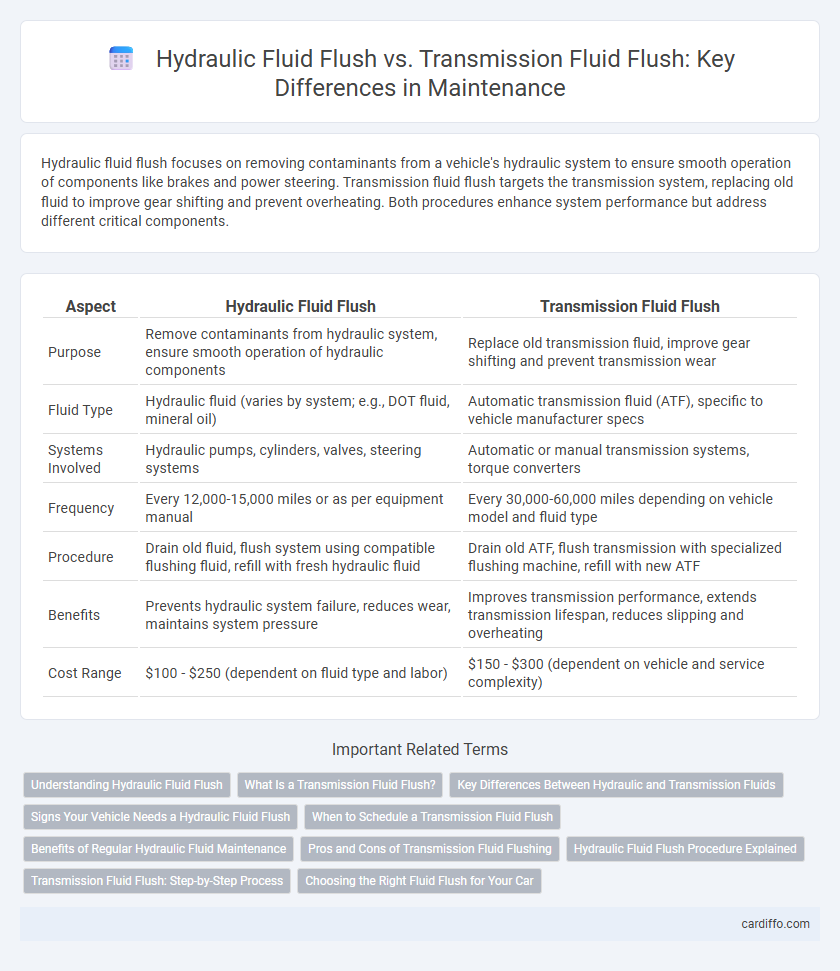Hydraulic fluid flush focuses on removing contaminants from a vehicle's hydraulic system to ensure smooth operation of components like brakes and power steering. Transmission fluid flush targets the transmission system, replacing old fluid to improve gear shifting and prevent overheating. Both procedures enhance system performance but address different critical components.
Table of Comparison
| Aspect | Hydraulic Fluid Flush | Transmission Fluid Flush |
|---|---|---|
| Purpose | Remove contaminants from hydraulic system, ensure smooth operation of hydraulic components | Replace old transmission fluid, improve gear shifting and prevent transmission wear |
| Fluid Type | Hydraulic fluid (varies by system; e.g., DOT fluid, mineral oil) | Automatic transmission fluid (ATF), specific to vehicle manufacturer specs |
| Systems Involved | Hydraulic pumps, cylinders, valves, steering systems | Automatic or manual transmission systems, torque converters |
| Frequency | Every 12,000-15,000 miles or as per equipment manual | Every 30,000-60,000 miles depending on vehicle model and fluid type |
| Procedure | Drain old fluid, flush system using compatible flushing fluid, refill with fresh hydraulic fluid | Drain old ATF, flush transmission with specialized flushing machine, refill with new ATF |
| Benefits | Prevents hydraulic system failure, reduces wear, maintains system pressure | Improves transmission performance, extends transmission lifespan, reduces slipping and overheating |
| Cost Range | $100 - $250 (dependent on fluid type and labor) | $150 - $300 (dependent on vehicle and service complexity) |
Understanding Hydraulic Fluid Flush
Hydraulic fluid flush entails completely replacing old hydraulic fluid to remove contaminants and ensure optimal system performance in machinery like excavators and forklifts. Unlike transmission fluid flush, which targets vehicle transmissions, hydraulic flush focuses on maintaining hydraulic pumps, valves, and cylinders by preventing sludge buildup and corrosion. Regular hydraulic fluid flushing extends equipment lifespan, enhances operational efficiency, and reduces costly breakdowns.
What Is a Transmission Fluid Flush?
A transmission fluid flush is a maintenance procedure that removes old, contaminated transmission fluid and replaces it with new fluid to ensure optimal performance and longevity of the vehicle's transmission system. This process helps eliminate sludge, debris, and varnish buildup that can impair shifting and cause wear on transmission components. Unlike a hydraulic fluid flush, which targets systems like power steering or brakes, a transmission fluid flush specifically services the automatic transmission system to maintain smooth operation and prevent costly repairs.
Key Differences Between Hydraulic and Transmission Fluids
Hydraulic fluid and transmission fluid serve distinct purposes, with hydraulic fluid primarily designed to transfer power in machinery using high pressure, while transmission fluid lubricates and cools the components within the transmission system. Hydraulic fluids typically have higher viscosity and better resistance to contamination and thermal degradation compared to transmission fluids, which are formulated with detergents and friction modifiers to optimize gear shifting and protect against wear. Understanding these key differences is crucial when performing a fluid flush, as using the incorrect fluid can lead to component failure and decreased system efficiency.
Signs Your Vehicle Needs a Hydraulic Fluid Flush
Signs your vehicle needs a hydraulic fluid flush include sluggish steering response, unusual noises when turning, and visible contamination or discoloration of the hydraulic fluid. Other indicators include leaks around the power steering pump or lines and a burning smell from the engine bay. Regular checks can prevent damage to the hydraulic system and ensure smooth vehicle operation.
When to Schedule a Transmission Fluid Flush
Schedule a transmission fluid flush every 30,000 to 60,000 miles to maintain optimal transmission performance and prevent costly repairs. Unlike hydraulic fluid flushes, which depend on specific system needs such as power steering or brakes, transmission fluid flushes are critical for automatic transmissions to avoid sludge buildup and overheating. Regular monitoring and following manufacturer recommendations ensure timely fluid replacement aligned with driving conditions and vehicle age.
Benefits of Regular Hydraulic Fluid Maintenance
Regular hydraulic fluid maintenance ensures optimal system performance by preventing contamination and reducing wear on components, extending the lifespan of valves, pumps, and seals. Flushing hydraulic fluid removes accumulated debris and moisture that can cause corrosion and system inefficiencies. Compared to transmission fluid flushes, hydraulic fluid flushes specifically protect heavy machinery and industrial equipment, maintaining consistent pressure and preventing costly breakdowns.
Pros and Cons of Transmission Fluid Flushing
Transmission fluid flushing removes old fluid, contaminants, and sludge, improving gear performance and extending transmission life. However, improper flushing can dislodge debris, causing blockages or damage in sensitive components. Regular transmission fluid flushes require professional service to balance cleaning effectiveness while minimizing risks of leaks or mechanical issues.
Hydraulic Fluid Flush Procedure Explained
Hydraulic fluid flush involves draining contaminated fluid from the system, replacing filters, and refilling with manufacturer-recommended hydraulic fluid to ensure optimal pressure and component protection. This procedure removes sludge, debris, and thermal breakdown products that impair valve function and pump efficiency. Completing a thorough hydraulic fluid flush maintains system responsiveness and extends the lifespan of hydraulic cylinders and motors.
Transmission Fluid Flush: Step-by-Step Process
Transmission fluid flush involves draining the old fluid through the transmission pan, followed by removing and cleaning or replacing the transmission filter to ensure contaminants are eliminated. Fresh transmission fluid is then poured into the system, and the vehicle is started to circulate the fluid, allowing for proper lubrication and cooling of transmission components. A final check includes inspecting for leaks and verifying the fluid level with the engine running and the transmission in park or neutral.
Choosing the Right Fluid Flush for Your Car
Selecting the appropriate fluid flush--hydraulic fluid flush or transmission fluid flush--depends on your vehicle's specific system and manufacturer recommendations. Hydraulic fluid flushes target brake and power steering systems to ensure optimal pressure and responsiveness, while transmission fluid flushes maintain gear performance and prevent overheating in automatic or manual transmissions. Regularly flushing the correct fluid enhances system longevity, prevents costly repairs, and preserves overall vehicle functionality.
Hydraulic Fluid Flush vs Transmission Fluid Flush Infographic

 cardiffo.com
cardiffo.com